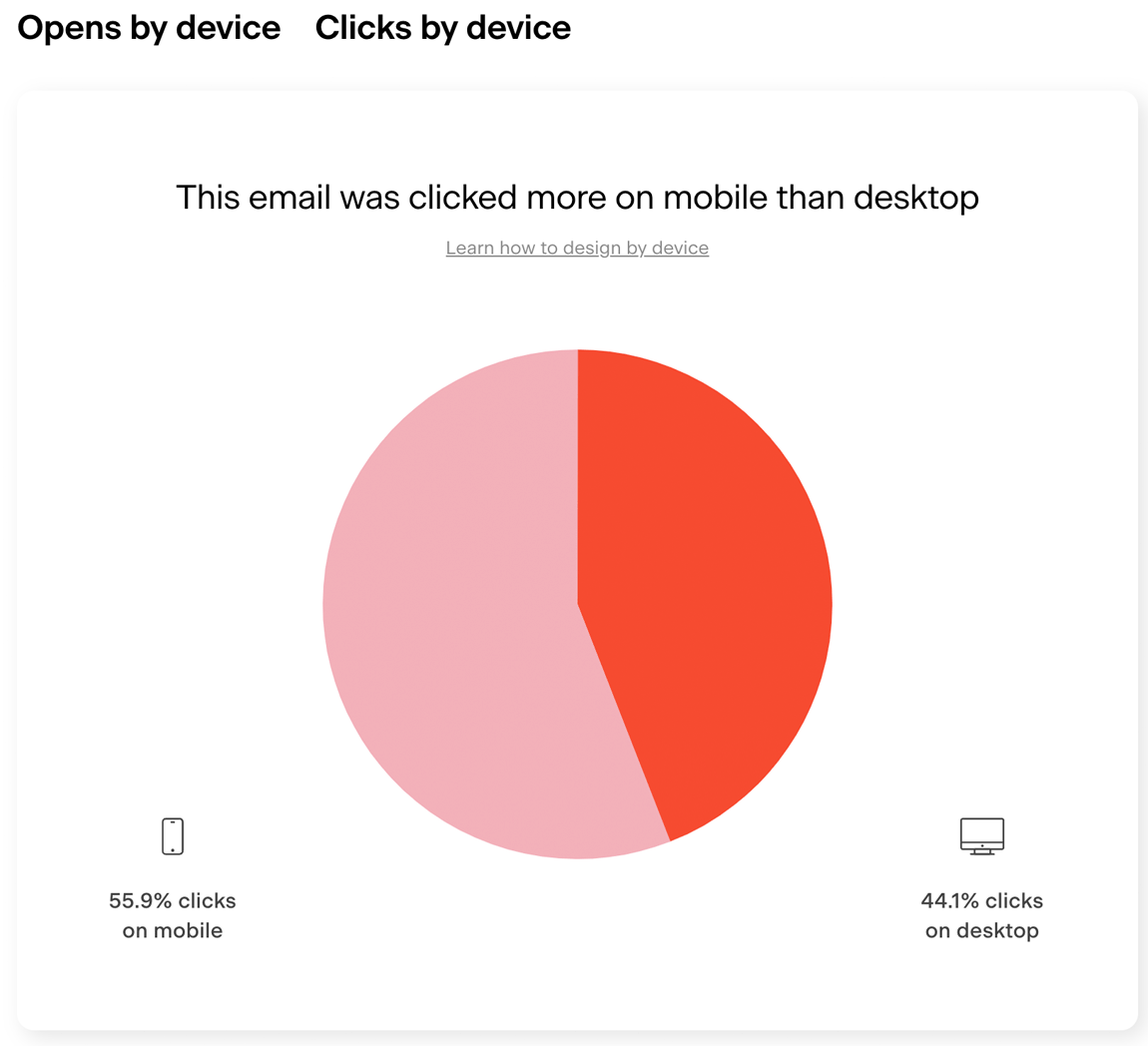5 Email metrics you should be tracking
Table of Contents Jump to:
Jump to:
Table of contents
TL;DR: Not sure which email metrics matter most? We’ve got five metrics you should be tracking to measure the success of your email marketing campaigns.
Imagine it’s the new year, and you’ve decided to make a resolution or set intentions. One of those is centered around fitness and hitting a daily step goal of 10,000 per day. You schedule brief walks with your dog every hour and a two-mile walk at the end of each day. You set reminders in your phone to make sure you keep up with your hourly walks and even let some friends know so they can hold you accountable. You’re on your way to success!
But you don’t have a fitness tracker or app that tracks your steps. You set a goal and created an action plan, but you have no way of seeing if you reached those goals. The same goes for your email marketing strategy if you don’t track metrics tied to your goals.
Do you want your list to read your blog posts to build trust and authority? Look at your clickthrough rate (CTR). Want your list to purchase your handmade jewelry? Track conversions. The important thing here is that you track metrics that help you understand your success. And if you’re not sure where to start, we’ve got five metrics you should track!
- Open rate
- Conversion rate
- Clickthrough rate (CTR)
- Bounce rates
- Device stats
Why you should track open rates
You find a beautiful template, take the time to customize it with your logo and brand colors, write a thoughtful email, and hit send. But how do you know if any of your subscribers opened the email?
Try thinking of your open rate as a measure of success (or failure) for your subject line, and treating your subject like as the ad copy that intrigues or excites your subscribers enough for them to open your email. Then, use your open rates to gain insights into whether your subject lines are effective.
Are your subject lines actually enticing? If they’re not performing how you’d hoped, try changing your subject line and then review your open rates again. Part of email marketing is trial and error, so if you rework your subject lines and your open rates improve, you can take those learnings to improve future iterations.
Not sure how you’re doing? Check your open rates in Flodesk.
While your open rate is most closely related to your subject lines, it can also indicate what your subscribers love (or don’t love so much).
Do you know which of your emails have the highest and lowest open rates? Do you see any trends? For example, if you notice that your emails with discount codes have the highest open rates but your bi-annual roundup newsletter has consistently low open rates, you can use that data to inform your email marketing strategy and understand what your subscribers want from you.
While open rates can help you optimize your subject lines and tailor your content, take them with a grain of salt. Many factors impact open rate, some of which you can’t control—like mail privacy protection capabilities and more.
Pro tip: Look through your email analytics to see who hasn’t opened your emails and resend to unopens. Do this sparingly though so you don’t overwhelm your subscribers’ inboxes.
How to calculate: (Emails opened/emails delivered) x 100. Ex: (40/100) x 100 = 40% open rate
Your email open rates are only part of the story though. It’s one thing to open an email, but another thing entirely to click around and even convert. Next, let’s dive into your conversion rate.
Why you should track your conversion rate
If you have an email list, you probably want your subscribers to convert, whatever that looks like—ebook downloads, product sales, webinar registrations. This is where tracking your conversions comes into play.
When you think about converting, think call-to-action (CTA). CTAs are typically buttons or links in your email that drive subscribers to take an action (your conversion). So, let’s say you have an upcoming webinar that you promote to your subscribers in a few emails. A few of them click on the registration button in your emails and complete the registration process. They converted.
How to calculate: (People who completed the desired action/total successful deliveries) x 100
Using the above formula, we can calculate your conversion rate for your webinar. You sent and successfully delivered 10,000 emails, and 1,500 subscribers signed up for your webinar. You calculate (1,500/10,000) x 100 to determine your conversion rate to be an impressive 15 percent. Not bad!
Not only do conversion rates help you measure your success, they give you little moments to celebrate. But if you’re unhappy with your conversion rate, you can also dig in and explore why you didn’t reach your desired conversion rate.
Read next: How to calculate subscriber value
Why you should track your clickthrough rate
Your clickthrough rate, commonly referred to as CTR, shows if your subscribers are simply opening your emails or actually engaging with them. Sure, they can open, scroll through, and close it. Or, they can click on every link and devour every word. Your CTR will help you determine if it’s the former or the latter.
Hubspot explains a key reason you should be tracking CTR: it can help you establish a baseline of engagement, making it easier to see changes over time.
Do you always see a spike during the holiday season? Have you made a few changes, and your CTR dropped in your last few email sends? You can also see which emails have the highest clickthrough rates to gauge the content your subscribers can’t get enough of—videos, blog posts, and more.
You just created a social media course you know your subscribers will love. You hope to drive course registrations by adding some stellar sales copy, photos, and a bold CTA to your weekly newsletter. To understand if this is a successful strategy, track your clickthrough rate and see how many people were interested enough to engage with your content and learn more.
Pro tip: It’s tempting to add links to your recent blog posts, your website, your CTA, testimonials, and more. But studies show that when we have too many choices, we make no choice. So keep it to a few key links and let your subscribers decide what they’re most interested in.
How to calculate: (Subscribers who clicked on your link/total subscribers who received your email) x 100. Ex: (1,000/5,000) x 100 = 20% CTR
Why you should track your bounce rates
We all have those short-term conversion goals, but have you thought about longer-term goals like maintaining a healthy, quality list? Your email bounce rate is an important metric for long-term success, but you don’t need to check it all the time.
Here’s why we recommend you check it every so often: if you have too many hard bounces, internet service providers (ISP) may view your emails as spam, hurting your sender reputation (and potentially, deliverability).
Having a large list seems like a dream, but you want the subscribers on your list to actually get your emails and be engaged. If they’re always bouncing, you won’t see any benefit. And oftentimes, people subscribe with fake email addresses, which add no value to your list. When you see them consistently bouncing, get rid of them!
Pro tip: Regularly clean your list of email addresses that bounce to maintain an engaged, valuable list. We also suggest using a double opt-in that requires subscribers to verify their email addresses.
Why you should review device stats
If you’re using Flodesk Email, you already know the importance of a beautiful experience. You create stunning emails that are not only breathtaking on a laptop or tablet but they’re optimized for mobile too. After all, who wants to put in all that work for the emails to look wonky on a mobile device? Not me!
This is the number one reason we recommend looking at how your subscribers view your emails. They should have a great experience, regardless of where they choose to open your email.
Think about it: how often do you check your email on your phone? I open my Gmail app more than any other app on my phone, especially when I’m working on the go. Your audience might be doing the same.
You don’t have to worry about optimizing your email for mobile with Flodesk—we do the hard work for you—but you may want to consider a few other things if your audience largely looks at your emails on their phones.
Did you create an ebook you want them to download? If it’s a 20-page ebook, maybe email isn’t the best place to share it. If you use intricate script headers, keep in mind they may be hard to read on mobile.
Pro tip: Keep your emails short, with clear CTAs your subscribers can spot on a desktop or mobile device.
Get to know your subscribers
Tracking email metrics is a great way to measure the success of your individual emails and as part of a greater campaign. But they also give you a glimpse into who your subscribers are, what they value, and how they like to consume your content.
Use the data from your metrics to tailor your emails to your subscribers. We think you’ll like the results!
Just getting started with email marketing? You’ve come to the right place. Get started with Flodesk for free for 30 days. We can’t wait to see what you do!







